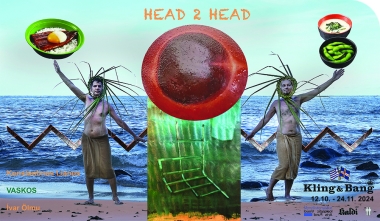 |
| |
 |
| Ivar Ölmu - Konstantinos Lianos - Vaskos |
| Head 2 Head |
| 12. 10. 2024 - 24. 11. 2024 |
| |
Ivar Ölmu presents Klukkur//Clocks and Rjóður kristaltrjáa//Glade of crystal trees, sculptural installations that reflect on the complex relation between the material remnants of industrial civilization and nature. Klukkur //Clocks are sculptural forms occurring from a manifold process of forces, among the artist´s gesture and the behaviour of natural and manmade materials. Found woodwork serve as molds to cast sculptural forms made out of concrete that have been exposed to the artist´s open-air studio, a beach in northern Iceland. The sea water interferes in the solidification process of the cement, this already man-made alloy, to intrude it with seaweeds, sand and stones as the ocean waves carve their imprint on it. Motion as time, erosion as healing and materiality as memory divulge the vulnerability of our anthropocentric world. The installation Rjóður kristaltrjáa//Glade of crystal, created indoors, at Ivar´s home studio follows the same line of narration of the tale of humanity as a material obsessed civilization, this time by employing found objects. A dismantled frame of a hardly identifiable industrial object serves as the relic of a nonhuman organism, on a monument created by humble materials imitating organic textures. A future monument, a former war machine or an ongoing construction, Ivar´s installation invokes a bewildered relation with the viewer as a mysterious and possibly hostile creature.
Konstantinos Lianos is exhibiting at Kling & Bang, showcasing for the first time his paintings Where everything began and Warmth from the upper mantle along with the sculptural installation Forever hidden sun as an immersive, three-dimensional visual bricolage. The artist intuitively explores the fragmented and intertwining plateaus that exist between the digital and physical realms. His paintings, created during a period of isolation and confinement, serve as visual amalgamations of dystopian futures alongside disjointed moments of contemporary life. Does the future include us, or are its dystopian scenarios already being revealed, fragmented within a perplexing and suffocating present? The foreboding images, borrowing a gaze from cinematic and natural landscapes, engage in a dialogue with Iceland's geological terrain and the flora of the southern Mediterranean, both of which are being significantly affected by climate changeeach at opposite ends of the temperature scale. Through meticulous technique and research-based craftsmanship, this imagery extends into the exhibition space, featuring a sculpture reminiscent of a model composition that includes an outrageously precise 3D-printed replica of a rare red moonfish. Known as the only warm-blooded fish, the moonfish embodies the artist's alarming realities in a startlingly soothing way. Suspended with other construction elements and posed on a pedestal inside the gallery, the moonfish recalls the former use of the Marshall House as a herring processing factory.
VASKOS present Letters From Tioman Island, a project arising from the duet´s travels in East Asia that revises the Western cultural narrative of Orientalism. A video documenting in situ staged performances of the artists, shot in Tioman island at the east coast of Peninsular Malaysia along with written material, multicultural sounds, 19th-century letters sent from exotic locales by notable artists like Gauguin, Rimbaud, and Flaubert, as well as haiku poems inspire a series of digital prints and a performance that will take place during the opening on the second day of H2H festival on the 12th of October.
VASKOS "sway drunkenly, lustfully, guiltily, and delightfully together" mocking the stereotypical superiority complex of the Western patriarchal gaze on indigenous cultures and nature. By queering the aesthetic tradition of the Odalisques, the duo challenges the narrative of travel and its evolution amid the booming tourism industry, as an ever-producing source of visual representations of the Other in contemporary culture. As artifacts, local fruits and vegetables are commodified as precious souvenirs, forming the material imprint of hybrid perceptions of exoticism, VASKOS critically speculate on contemporary definitions of the Orient: what precarious geographical and sociological subjects, human and non-human entities, do we consume today through our voyeuristic adventures?
Christina Petkopoulou
|
| |
|
| |
|
|
|
Grandagarğur 20 - 101 Reykjavík
kob@this.is |
